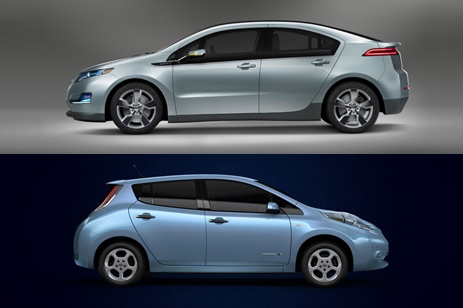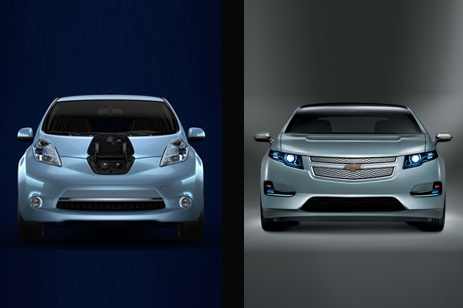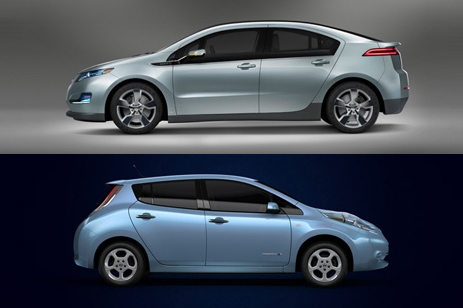 Chevy Volt (top) and Nissan Leaf (bottom).Are you a Volt kind of gal or a Leaf guy?
Chevy Volt (top) and Nissan Leaf (bottom).Are you a Volt kind of gal or a Leaf guy?
With General Motors and Nissan revving up to put the first mass-produced electric cars in showrooms in a few months, the shape of the nascent market is starting to emerge as the engineers complete their work and the marketers begin theirs.
The cars, the Chevrolet Volt and the Nissan Leaf, take two different technological roads to sustainable transportation, and their differing appeal was on display Monday when I spent the afternoon at the Plug-In 2010 conference in San Jose. (Even the cars’ names telegraph their shades of green.)
First I took a test drive of a metallic blue Leaf parked outside the Hotel Valencia in San Jose’s upscale Santana Row shopping district. Like the Toyota Prius, the five-seater Leaf has a distinctive shape that lets your neighbors know you’ve gone green — that and the logo emblazoned on the side that screams “zero emission” in big letters.
Nissan clearly is targeting the Prius set. Inside, the Leaf features a clean minimalist interior with just enough high-tech touches to let you know you that this is not your grandma’s Sentra. Move the big and round blue LED-illuminated knob in the center console to the left and down and the Leaf is in gear. (Press the button on the top of the knob to put the Leaf in park.)
Like every other electric vehicle I’ve driven, the Leaf accelerates quickly as power is instantaneously transferred to the wheels, albeit not as silently as other EVs. Nissan has implanted speakers under the wheel wells that broadcast a low sound somewhat like a starship going into warp to warn unsuspecting pedestrians that a car is coming.
Touch a button on the big dashboard screen and the Leaf tells you how many miles you can travel on the battery’s remaining charge and displays a map showing just how far you can go in any direction. Another button displays the location of charging stations — which are very few and far between in San Jose at the moment.
Other than the iPhone-like features, the Leaf drives and handles like any other compact car. Which is the point, after all, for automakers seeking to make electric cars as common as the Honda Civic.
Still, Nissan is clearly targeting the enviro crowd that made the Prius a hit and broke down barriers for electric cars.
“Basically everything you see here is made out of recycled water bottles, right down to the floor mats,” the Nissan representative riding shotgun points out about the interior.
If that doesn’t provide enough green cred at the neighborhood cocktail party, there’s the optional solar panel that does double duty as a spoiler. (“Ninety-nine percent bragging rights, one percent function,” concedes the Nissan rep.)
But what about the Volt?
 Nissan Leaf (left) and Chevy Volt (right).That same evening, I attended a dinner where GM executives at long last revealed the sticker price of the Volt: $41,000, versus $32,780 for the Leaf, before a $7,500 federal tax credit.
Nissan Leaf (left) and Chevy Volt (right).That same evening, I attended a dinner where GM executives at long last revealed the sticker price of the Volt: $41,000, versus $32,780 for the Leaf, before a $7,500 federal tax credit.
Although GM calls the Volt an “extended range electric vehicle,” it is in fact a serial hybrid that will travel 40 emission-free miles on a charge from its lithium ion battery pack. When the battery runs down, a small gasoline engine kicks in to power a generator that delivers electricity to the car’s motor. That lets the Volt go 340 miles, dispelling range anxiety. (Nissan says the Leaf can travel up to 100 miles on a charge.)
“This car is designed for the majority of Americans,” Joel Ewanick, GM’s vice president for North America marketing, said at the dinner. “This is a car that the average person can drive on a daily basis. It’s not something that’s a unique little niche vehicle.”
The Volt has an aggressive muscular stance and an interior choc-a-block with buttons and ports (plus a 32-gig hard drive for your music collection) that should appeal to the Camaro crowd as well as greenies. (It’s also fun to drive, as I found out when I took the Volt for a spin a couple of months ago.)
So, which to choose?
The reality is that both types of cars are needed to accelerate the transition away from gasoline-powered vehicles, and both vehicles present conundrums to potential buyers.
As I tooled around in the Leaf, I realized that if I had driven the car down to San Jose from Berkeley, I wouldn’t have enough juice to make a return trip. On the other hand, if I had taken the Volt, I would have been burning carbon for more than half the trip.
Clearly, the electric-car market will need both the Volt and the Leaf in the coming years.
And a lot of fast-charging stations.



